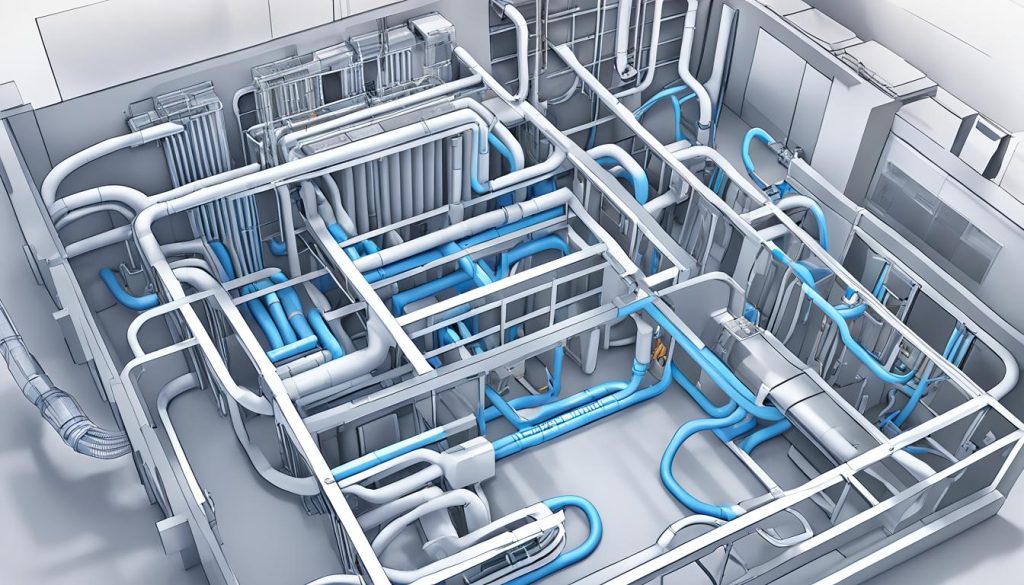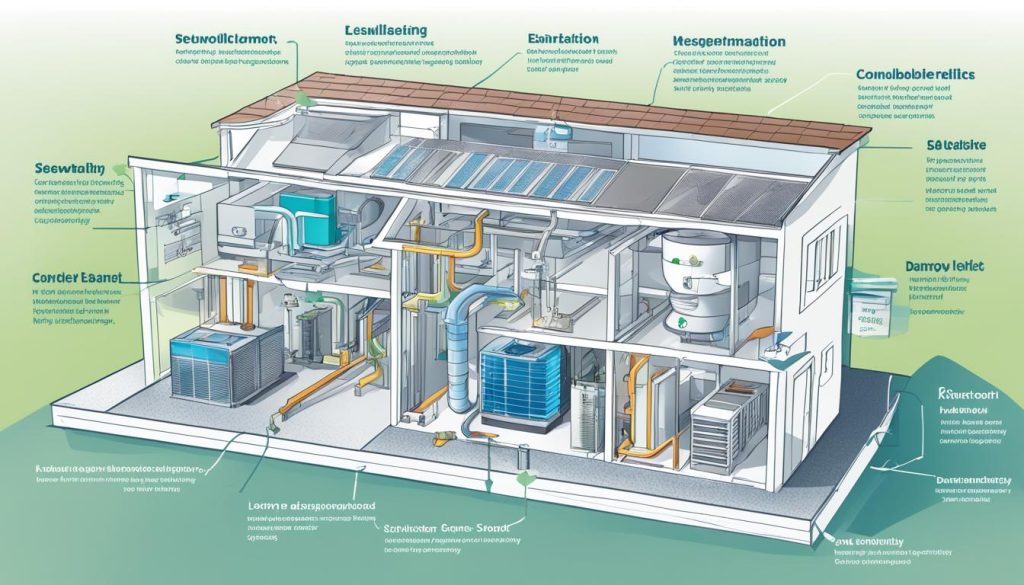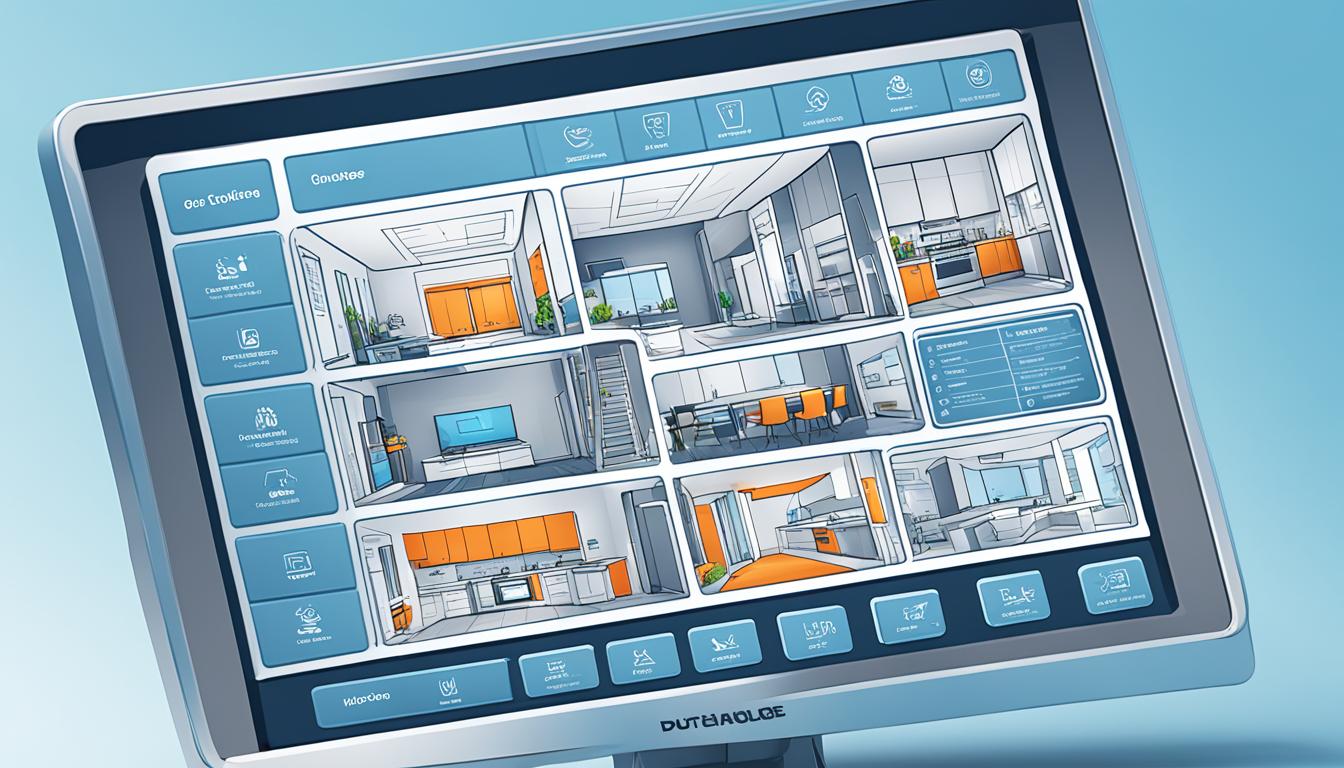Designing energy-efficient duct systems is easy with HVAC software. It offers powerful tools for 2D and 3D modeling, duct sizing, and optimizing layouts. This makes creating sustainable HVAC solutions simpler, ensuring your designs follow industry standards and boost system performance.
HVAC duct design software has many features to help you make precise and effective ductwork. You can create automatic ductwork layouts, pick the right materials, estimate costs, and check energy efficiency. This software helps you optimize HVAC ductwork for the best efficiency, cutting down energy use and costs in buildings.
Whether you’re an HVAC engineer or a DIY fan, these software solutions let you design energy-efficient HVAC systems affordably. Exploring HVAC duct design software shows how it can change your approach to making heating, ventilation, and air conditioning systems sustainable and efficient.
Understanding the Importance of Energy-Efficient Duct Systems
Energy-efficient HVAC systems are key for today’s buildings. The ductwork is a big part of these systems, impacting how well they work and how much energy they use. Let’s see why making ducts efficient is important for saving energy and building green.
The Role of Ductwork in HVAC Efficiency
Ductwork is like the heart of your HVAC system. It spreads air all over your building. Good duct design means better airflow, steady temperatures, and less energy waste. Making ducts work better is crucial for the best system performance.
Energy Losses in Typical Duct Systems
Most duct systems lose a lot of energy. Leaks, bad insulation, and wrong sizes can waste 25-40% of the energy your system makes. This means higher bills and less comfort for you.
| Duct System Component | Potential Energy Loss |
|---|---|
| Air Leaks | 10-20% |
| Poor Insulation | 5-15% |
| Improper Sizing | 10-15% |
Impact on Building Energy Consumption
Bad duct systems use more energy. Sometimes, only half the heating or cooling gets where it should. This inefficiency increases costs and hurts your green building goals. By optimizing HVAC ductwork, you can cut energy use and lessen your environmental impact.
Introduction to HVAC Duct Design Software
HVAC duct design software has changed how professionals work in commercial HVAC engineering. It lets you make efficient and green HVAC solutions easily. With advanced modeling, you can make ductwork designs that work better and save energy.
The software has easy-to-use interfaces for making 2D and 3D models of duct systems. This helps you spot problems early, saving time and money. It also has features to quickly make designs that meet standards and codes.
One big plus of HVAC duct design software is how it optimizes duct sizes and layouts. It uses complex algorithms and engineering to make sure your designs are efficient. This can mean big energy savings and better system performance.
| Feature | Benefit |
|---|---|
| 2D/3D Modeling | Improved visualization and issue detection |
| Automatic Ductwork Generation | Time-saving and code-compliant designs |
| Optimization Algorithms | Enhanced energy efficiency and system performance |
| Cost Estimation Tools | Accurate budgeting and material planning |
If you’re new to HVAC system modeling, there are free versions of duct design software. These are great for beginners and offer powerful features without costing a lot. As you get better, you might want to move to professional versions for bigger projects.
Key Features of HVAC Software for Duct Design
HVAC duct design software has tools that make designing your system easier. These tools help with planning, sizing, and optimizing ductwork. Let’s look at what makes top HVAC software stand out.
2D and 3D Modeling Capabilities
Modern HVAC software lets you create detailed 2D layouts and 3D models. You can see duct runs, equipment placement, and potential problems before you start. This helps find issues early and makes the installation smoother.
Automatic Ductwork Generation
Forget about manual duct sizing and layout. Advanced programs can create the best ductwork designs for you. Just input airflow rates and space, and the software takes care of the rest. This saves time and cuts down on mistakes in load calculations.
Energy Efficiency Analysis Tools
Top HVAC software comes with energy analysis tools. These tools help you make your designs as efficient as possible. You can test different scenarios, compare energy use, and find ways to improve. This approach leads to more efficient and cost-saving HVAC systems.
Material Selection and Cost Estimation
Comprehensive duct design programs have material libraries and cost estimators. You can pick from different duct types, insulation, and fittings. The software then tells you how much material you need and estimates the cost. This helps you plan for performance and budget during design.
Using these features, you can design HVAC systems with confidence. The right software makes duct sizing and layout tasks easier and more accurate.
Steps to Design Energy-Efficient Duct Systems Using HVAC Software

Designing energy-efficient duct systems with HVAC software is a step-by-step process. It helps create systems that work better and are good for the planet. By following these steps, you can make HVAC systems that save energy and support green building.
Begin by making detailed 2D or 3D models of your building and HVAC setup. Add important details like airflow rates, duct sizes, and pressure. Many software tools can automatically create ductwork based on your building and industry standards, making it easier to start.
Then, work on optimizing your HVAC ductwork. Use the software to adjust duct sizes and layouts for better efficiency. This is key to cutting energy waste. The software can also analyze energy efficiency and let you compare different designs.
Remember to do HVAC load calculations to make sure your system fits the building’s needs. These calculations prevent your system from being too big or too small. This avoids inefficiency and saves energy.
Lastly, pick materials and estimate costs with the software’s tools. This helps you find a balance between cost and performance. Your duct system will be both efficient and affordable.
- Create accurate building and HVAC system models
- Input crucial system variables
- Generate initial ductwork layout
- Optimize duct sizing and layout
- Perform energy efficiency analysis
- Conduct HVAC load calculations
- Select materials and estimate costs
By following these steps and using HVAC software, you can make duct systems that save a lot of energy. This supports sustainable building practices.
Optimizing Duct Sizing and Layout for Maximum Efficiency
Optimizing your HVAC ductwork is key to making your system more energy-efficient. By getting the duct sizes and layout right, you can boost your system’s performance and cut down on energy use.
Calculating Proper Duct Sizes
Getting the duct sizes right starts with accurate load calculations. Use HVAC software to figure out the best duct sizes. This takes into account airflow needs, friction rates, and static pressure. It helps ensure air moves well throughout your building.
| Duct Size (inches) | Airflow Capacity (CFM) | Recommended Velocity (FPM) |
|---|---|---|
| 6 | 100-200 | 600-900 |
| 8 | 200-400 | 700-1000 |
| 10 | 400-600 | 800-1200 |
| 12 | 600-900 | 900-1300 |
Minimizing Pressure Drops and Air Leakage
Design your duct system for smooth paths and few bends to cut down on pressure drops. Use software to spot where air might leak and seal those spots well. This makes your system work better and saves energy.
Balancing Airflow Distribution
Plan your duct routes and sizes for even airflow. Use software to try out different layouts and adjust dampers for the best balance. This is key for keeping everyone comfortable and making your HVAC system work its best.
By following these steps, you can make a duct system that supports an energy-efficient HVAC setup. Remember, spending time on good duct design leads to better performance and lower costs.
Integrating Energy-Efficient Components in Duct Design
Energy-efficient HVAC systems are key in green building HVAC design. By adding advanced parts to your duct system, you can greatly improve efficiency and cut energy use. Let’s see how to use HVAC system modeling software to add these elements.

HVAC software lets you pick and check out various energy-saving parts for your duct design. These include:
- High-efficiency air handlers
- Energy recovery ventilators
- Variable air volume (VAV) systems
- Smart thermostats and zoning controls
Adding these parts helps make HVAC systems that are good for the planet. The software’s tools show how each part helps, making it easier to see why investing in energy-efficient tech is a smart move.
| Component | Energy Savings | Cost Impact |
|---|---|---|
| Energy Recovery Ventilator | 15-40% | Medium |
| High-Efficiency Air Handler | 10-20% | High |
| VAV System | 20-30% | Medium-High |
| Smart Zoning Controls | 15-25% | Low-Medium |
HVAC system modeling software lets you test different setups and see how they affect energy use. This approach helps you choose the best parts for your design, balancing efficiency with cost.
Analyzing and Improving System Performance with HVAC Software
HVAC system modeling tools are great for making energy-efficient HVAC systems better. With these advanced software, you can check and improve your duct designs for top performance.
Running Energy Simulations
Energy simulations are crucial for checking HVAC system efficiency. They let you test your designs in different conditions. This helps spot problems before you install them.
You can change climate, occupancy, and equipment settings to see how your system does. This way, you can find out how it will work in real life.
Identifying Areas for Improvement
HVAC load calculations show where your system design is weak. The software points out where energy is lost or airflow is poor. This helps you know exactly where to make changes.
This approach saves time and money by focusing on the most important improvements.
Comparing Different Design Scenarios
HVAC software is great at comparing different design options. You can change settings and see how it affects energy use and performance. This is very useful for making HVAC systems that are good for the planet.
| Design Scenario | Energy Consumption | Initial Cost | Long-term Savings |
|---|---|---|---|
| Standard Ductwork | High | Low | Minimal |
| Optimized Layout | Medium | Medium | Moderate |
| High-Efficiency System | Low | High | Significant |
Using these powerful tools, you can make smart choices. You can create HVAC systems that save money, are more comfortable, and work better.
Best Practices for Implementing Energy-Efficient Duct Systems
To make your HVAC systems use less energy, focus on the design and installation of ducts. Start by sealing all duct joints and connections well. This can cut energy losses by up to 40% in most homes.
Insulate ducts, especially in areas like attics or crawl spaces that are not heated or cooled. This helps stop heat from moving through the ducts and makes the system work better.
Try to put ducts inside conditioned spaces if you can. This can greatly improve how well your system works, aiming for 100% duct efficiency. It’s important for green building HVAC design, helping save energy and make buildings more comfortable.
Regular maintenance is also key. Have your system checked and cleaned to keep it running efficiently over time.
Use HVAC software for designing and analyzing ducts. These tools help you apply best practices, making your systems more efficient and cost-effective. By following these steps, you’ll have HVAC solutions that save energy and support building sustainability. Every improvement in duct efficiency means less harm to the environment and more savings in the long run.





0 Comments